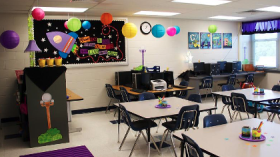
Different seasons bring different risks
Think the onset of summer reduces the risks faced by schools? Think again. Fiona Riley, chair of the Institution of Occupational Safety and Health’s Education Group examines some of the risks
Different seasons bring about different health and safety risks for schools. We have all heard how allowing children to play outside is good for them – and it is – and seen images of youngsters enjoying an ice cream while the sun beats down on them. However, we need to be aware of the risks brought about by the warmer weather and how they can be controlled.
Solar radiation
The impact of solar radiation can be devastating. Exposure to the sun is the main cause of skin cancer. It is linked to 65 per cent of malignant melanoma and 99 per cent of non-melanoma skin cancer.
In schools we have to manage the risks for both adults and children. How, then, do we manage it? We cannot keep children indoors all of the time, though when temperatures are extremely hot it can be beneficial to prevent them from going outside.
When children are outside there are a number of control measures which can be put in place to prevent them – and indeed staff – from being harmed.
In my role at an independent day school, I have used the free resources provided by the Institution of Occupational Safety and Health (IOSH). Solar radiation is one of the focuses of its No Time to Lose campaign on occupational cancer. These resources, available at www.notimetolose.org.uk, look at the risks and provide easy steps for organisations, including those in the education sector, on how to manage them.
Many people assume that applying sunscreen is all they need to do if they are spending time in the sun. However, this is very much a last line of defence and schools should consider other measures first.
In a lot of settings, especially early years ones, canopies have been put up to provide large amounts of shade. This is just one way of removing the risk and still allowing children to be outside.
Covering up with suitable clothing is also a key way of avoiding skin damage by the sun. Clothing should not leave parts of skin exposed and special consideration must be given to people’s heads. Many schools I’m aware of have a protocol in place where children must wear hats if they are outside during warm weather. Particularly useful are hats which cover the back of the neck and ears.
These are some of the first considerations that must be given. But we cannot forget sunscreen, while also reiterating the fact that we shouldn’t rely on it by itself.
Children of course should use a very high factor sunscreen of 50, while adults are recommended to use one of around 30 to offer them protection.
An important point with sunscreen is that it doesn’t offer protection for the first 20 to 30 minutes after applying it as it needs to be absorbed into the skin. Of course it needs to be reapplied regularly at least every two to three hours. Another key point a lot people do not realise is that sun protection can have a very short shelf life so check the expiry date.
There are issues however in schools with applying sunscreen to children as it involves actually touching them, so this is a quite a challenging situation.
And in addition, schools must remember that it doesn’t have to be sunny for skin to be damaged, so these steps should be followed in cloudy conditions – as up to 80 per cent of dangerous UV rays can get through cloudy skies.
The recommendation is that the sun’s rays in the UK can be harmful for longer than just the summer months and sunscreen is recommended for children from March to October.
Other heat-related risks
The risk of skin cancer isn’t the only issue we have to contend with. Heat exhaustion can be a serious issue in children, as can sunstroke.
It is important therefore that staff in schools are able to get a grip on what the signs are so they can spot them and take action before major issues arise.
The onset of heat exhaustion in children can be very sudden and can lead to febrile convulsions. This is particularly the case in small children – those aged up to five or six – as they are unable to control their body temperature.
Early years providers have got a real handle on this, as part of the requirements for the Foundation stage framework since April 2016. Staff now having to be trained in paediatric first aid, but when you move further up the educational ladder this is not always the case.
According to the NHS website, the main signs of heat exhaustion in children are headache; dizziness and confusion; loss of appetite and feeling sick; excessive sweating and pale, clammy skin; cramps in the arms, legs and stomach; fast breathing or pulse; temperature of 38C or above; and intense thirst.
It isn’t just outside where the effects of warm conditions can be felt. The inside of some schools can be incredibly hot.
New school buildings, including the younger years building where I work, often have air conditioning. However other buildings, including our 105-year-old building, do not have such luxuries so we have to look at other means of keeping cool.
In these circumstances you need to look managing the risks associated with the upper temperature ranges be it bringing in fans, opening the windows and other means of keeping a room cool. There is no upper limit for workplace temperatures but it is important that they do not get too hot.
Taking classes outside can be considered, especially if you have got shaded areas. As discussed, we are trying to avoid exposing children and staff to solar radiation here. One place in schools such as ours where we have issues with heat is the kitchen. In the summer months it gets very hot and we have no choice but to rotate staff frequently, consider what the menu is to manage related risks.
Away from schools
We have a responsibility in schools to ensure that children stay safe when they aren’t in school.
Older children often spend a lot of time during summer holidays without the supervision of parents and it is crucial, therefore, that we educate them on particular risks. These include water hazards. There are so many stories of young people getting into difficulty while swimming in water where there are no lifeguards around.
On a hot day it can be very tempting to jump into some water just to cool down. This is incredibly dangerous so we have to ensure that young people are clued up about these risks.
The same goes for playing around building sites. Most construction firms are getting very good now about having good perimeter security around their sites but, as schools, we still have a role to play in educating children
of the risks that may be present on these sites.
So, as we head towards the summer holidays, we have to keep managing risks. We have to do all we can to ensure children’s health as well as safety is not compromised in any way, whether that be on the school’s grounds or away from it.
Further Information:Latest News
12/12/2025 - 11:39
The government has announced at least £3 billion to create tens of thousands of new speci
12/12/2025 - 07:07
The findings suggest that children and young people attending schools in the North of England are less likely to take part in and benefit from residential visits.
11/12/2025 - 13:52
Ofqual has launched a 12-week public consultation on its proposed approach to regulating on-screen exams in GCSEs, AS and A levels.
11/12/2025 - 09:49
A report by Ofsted and the Care Quality Commission (CQC) finds that support for children with special educational needs and/or disabilities (SEND) who do not attend school full-time is too inconsistent.
11/12/2025 - 09:37
The easy-to-use web-based tool is designed to help schools estimate how an air filter unit could impact air quality and energy consumption in a classroom.







